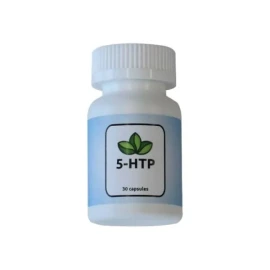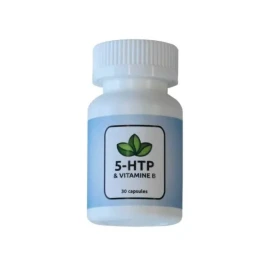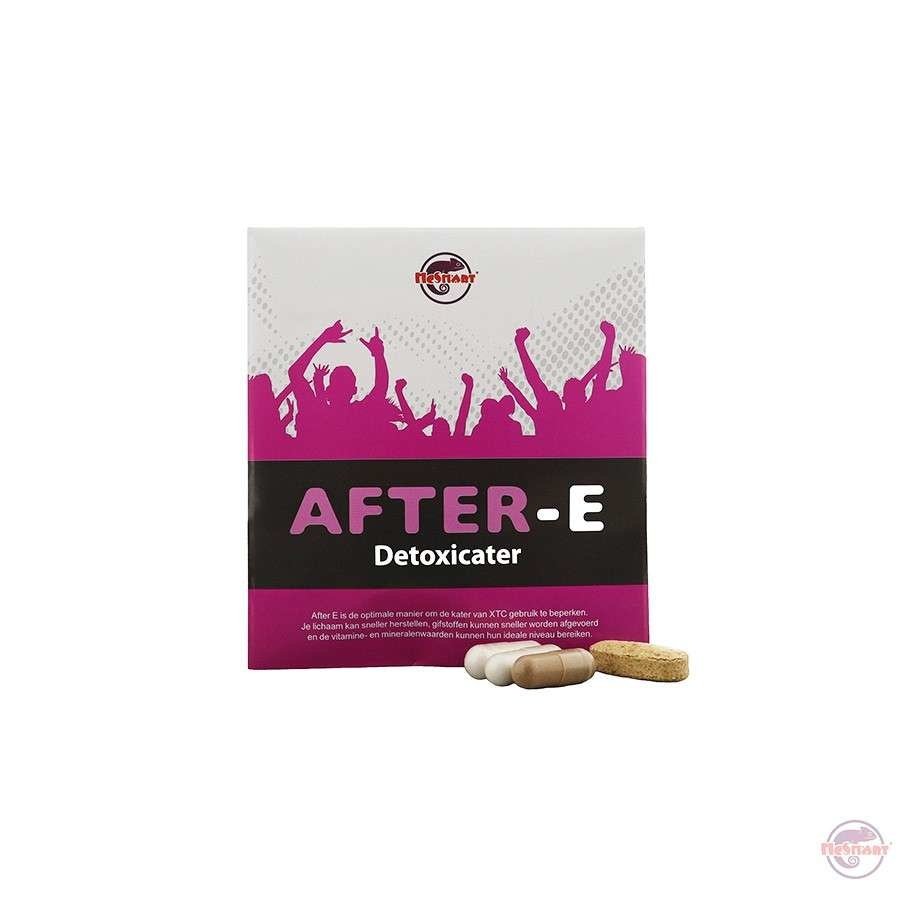5-HTP
16,00 €
Quick Facts About 5-HTP
What it is: 5-hydroxytryptophan, an immediate biochemical precursor to serotonin
Typical supplement dose range: 100–400 mg/day (warning: doses exceeding 6 g/day are unsafe)
Common uses: Mild depression, sleep support, appetite control, migraine prevention (evidence strength varies)
Main natural source: Seeds of Griffonia simplicifolia
Key safety considerations: Potential interactions with SSRIs/MAOIs, not recommended during pregnancy or for children, unknown long-term safety profile
What is 5-HTP?
5-hydroxytryptophan represents a critical intermediate compound in the body’s production of serotonin. Unlike serotonin itself, which cannot cross the blood-brain barrier when taken as a supplement, 5-HTP readily passes into the brain where it can be converted directly into serotonin. This unique property makes it particularly valuable as a supplement for those seeking to influence their serotonin levels naturally.
The primary commercial source of 5-HTP comes from the seeds of Griffonia simplicifolia, an African shrub. These seeds contain naturally high concentrations of 5-HTP, typically ranging from 5-20% by weight in quality extracts. The extraction process involves careful processing to concentrate the active compound while removing other plant materials and potential contaminants.
While 5-HTP can also be produced synthetically in laboratories, most supplements on the market derive from natural plant sources. The distinction matters for labeling accuracy and quality control, as natural extracts require careful testing to ensure purity and potency consistency. When evaluating supplements, the percentage of 5-HTP content directly impacts the effective dose delivered per capsule or serving.
Historically, interest in 5-HTP supplementation grew from research into serotonin’s role in mood and sleep disorders. As scientists better understood the serotonin pathway, they recognized that supplementing with 5-HTP could potentially bypass some of the rate-limiting factors that make direct serotonin supplementation ineffective.
How 5-HTP Works: The Science
The biochemical pathway from dietary protein to mood regulation follows a fascinating sequence: dietary tryptophan converts to 5-HTP, which then transforms into serotonin, and finally, in the pineal gland, serotonin can convert to melatonin. This cascade explains why 5-HTP supplementation can potentially influence both mood and sleep patterns.
The conversion of 5-HTP to serotonin occurs through the enzyme aromatic L-amino acid decarboxylase, found throughout the nervous system. This process bypasses the rate-limiting step that occurs when the body converts tryptophan to 5-HTP, making 5-HTP supplementation potentially more efficient than tryptophan for raising brain serotonin levels.
Once serotonin levels increase in the brain, several mechanisms come into play. Serotonin influences mood through its action on various receptor subtypes throughout the central nervous system. It affects sleep architecture by modulating the sleep-wake cycle and can influence the production of melatonin during evening hours. For appetite control, serotonin acts on specific receptors in areas of the brain responsible for satiety and food cravings.
The practical implications of this pathway become important when considering timing and dosing. Because 5-HTP can be converted to serotonin relatively quickly, effects may be noticed sooner than with tryptophan supplementation. However, this also means that interactions with other serotonergic substances become more significant, as the additive effects can potentially lead to excessive serotonin activity.
Understanding this mechanism also explains why 5-HTP might be effective for multiple conditions that share serotonin involvement, though the evidence quality varies significantly between different applications.
Evidence-Based Benefits: What Research Shows
The scientific evidence supporting 5-HTP supplementation varies considerably depending on the condition being addressed. Research quality ranges from well-designed clinical trials to preliminary studies with significant limitations.
Major Depressive Disorder and Mild Depression
The strongest evidence base exists for 5-HTP’s potential benefits in mood disorders. Multiple clinical trials and meta-analyses have examined its effects on depression symptoms, typically using doses between 100-300 mg daily, often divided into multiple doses throughout the day.
Results from these studies show modest but statistically significant improvements in mood compared to placebo in many trials. Effect sizes tend to be moderate, and the improvements often become apparent after several weeks of consistent use. However, most individual studies have been relatively small and short-term, limiting the ability to draw definitive conclusions about long-term efficacy.
The evidence suggests that 5-HTP may be particularly beneficial for mild to moderate depression, though it should not be considered a replacement for clinically indicated antidepressants without proper medical supervision. The heterogeneity in trial designs and participant populations contributes to variability in reported outcomes.
Sleep and Insomnia Support
Research on 5-HTP for sleep concerns shows limited to moderate evidence of benefit. Studies typically employ doses ranging from 50-200 mg taken 30-60 minutes before bedtime. The proposed mechanism involves 5-HTP’s conversion to serotonin and subsequently to melatonin, particularly during evening hours when the pineal gland naturally increases melatonin production.
Several small trials have reported improvements in sleep onset time and overall sleep quality among participants taking 5-HTP compared to placebo. However, results remain mixed across studies, and the timing of administration appears crucial for effectiveness. The formulation type and individual variations in metabolism also seem to influence outcomes significantly.
Appetite Control and Weight Management
The evidence for 5-HTP in appetite control remains limited but intriguing. Some short-term trials using doses of 100-400 mg daily in divided doses have reported reduced carbohydrate intake and decreased overall appetite among participants. These effects likely result from serotonin’s role in satiety signaling within the brain.
However, long-term weight loss evidence remains weak, with most studies lasting only a few weeks to several months. The appetite suppression effects appear to be most pronounced in the initial weeks of supplementation, with some adaptation occurring over time.
Migraine and Headache Prevention
Limited evidence suggests potential benefits for migraine prevention, though research remains preliminary. Small trials have reported reduced frequency and severity of migraines in some individuals taking 5-HTP, but larger, more rigorous studies are needed to establish clear efficacy.
Anxiety and Other Conditions
Evidence for anxiety reduction remains insufficient, based primarily on anecdotal reports and very small trials. Similarly, claims about fibromyalgia and other chronic pain conditions lack robust clinical support, though preliminary data exists in some areas.
The evidence landscape shows that while 5-HTP demonstrates the most promise for mild depression and potentially sleep support, many other claimed benefits require additional research before definitive recommendations can be made.
Safety, Side Effects & Critical Interactions
Understanding the safety profile of 5-HTP is essential due to its potent effects on serotonin systems and potential for serious interactions with commonly prescribed medications.
Common Side Effects
Clinical trials consistently report gastrointestinal side effects as the most frequent adverse reactions. These include nausea, diarrhea, abdominal discomfort, and general digestive upset. Studies suggest that approximately 35% of individuals taking 5-HTP experience mild adverse effects compared to 29% taking placebo, indicating a real but generally manageable side effect profile.
Neurological side effects can include headache, drowsiness, and notably vivid or unusual dreams. These effects often relate to the timing of administration and individual sensitivity to serotonin changes.
Serious Risk Considerations
Serotonin Syndrome represents the most critical safety concern with 5-HTP supplementation. This potentially life-threatening condition can occur when serotonin levels become excessively elevated, particularly when 5-HTP is combined with prescription antidepressants (SSRIs, SNRIs, MAOIs), certain migraine medications (triptans), or other serotonergic substances.
Symptoms of serotonin syndrome include rapid heartbeat, high blood pressure, agitation, confusion, muscle rigidity, hyperreflexia, fever, and sweating. Anyone experiencing these symptoms while taking 5-HTP should discontinue use immediately and seek emergency medical care.
Eosinophilia-Myalgia Syndrome (EMS) represents a historical concern linked to contaminated tryptophan and 5-HTP supplements. While rare with properly manufactured products, this serious condition underscores the importance of choosing supplements from reputable manufacturers with rigorous quality control and third-party testing.
Drug and Supplement Interactions
Several categories of medications require special caution or complete avoidance when considering 5-HTP:
Antidepressants: SSRIs, SNRIs, and MAOIs all increase serotonin activity and should generally not be combined with 5-HTP without medical supervision due to serotonin syndrome risk.
Migraine Medications: Triptans and other serotonergic migraine treatments can interact dangerously with 5-HTP.
Parkinson’s Medications: Carbidopa and levodopa can interact with 5-HTP, requiring specialist consultation before combination.
Other Serotonergic Supplements: St. John’s wort, SAM-e, and other mood-supporting supplements may create additive serotonergic effects.
Populations Requiring Special Caution
Pregnancy and Breastfeeding: Insufficient safety data exists for 5-HTP use during pregnancy or lactation, making it inadvisable for these populations.
Children and Adolescents: Limited safety and efficacy data in younger populations means 5-HTP should be avoided unless specifically recommended by a pediatric specialist.
Bipolar Disorder: 5-HTP may potentially trigger manic episodes in susceptible individuals and requires careful psychiatric supervision.
Pre-existing Medical Conditions: Individuals with cardiovascular disease, liver problems, or other significant health conditions should consult healthcare providers before starting 5-HTP.
Dosing Safety Parameters
Typical supplement dosing ranges from 100-400 mg daily, with most clinical trials staying within this range. Doses exceeding 6 grams daily are considered unsafe and significantly increase the risk of serious adverse effects.
Long-term safety data remains limited, making indefinite use inadvisable without medical monitoring. Most clinical trials have examined short-term use over weeks to months rather than years.
Dosage, Forms, Timing & Duration Guidelines
Effective 5-HTP supplementation requires careful attention to dosing, timing, and duration based on clinical trial data and individual response patterns.
Evidence-Based Dosing Recommendations
Clinical trials typically employ starting doses of 50-100 mg daily, with gradual titration upward based on response and tolerance. For mood support, divided dosing throughout the day (morning and afternoon) has been used in some protocols, with total daily doses ranging from 100-300 mg.
Sleep support applications often utilize single doses of 50-200 mg taken 30-60 minutes before bedtime. This timing allows for conversion to serotonin and potentially melatonin during the natural evening rise in melatonin production.
A conservative titration schedule might progress as follows: Week 1 involves 50-100 mg daily to assess tolerance, Week 2 may increase to 100-200 mg if well-tolerated, and subsequent weeks can adjust within the 100-400 mg range based on response. Doses above 400 mg daily should only be used under specialist medical supervision.
Available Forms and Considerations
5-HTP supplements come in various forms, each with distinct advantages. Standard capsules and tablets offer precise dosing and stability, while sustained-release formulations may provide more consistent blood levels throughout the day. Powder forms allow for flexible dosing but require careful measurement and may have stability concerns.
When evaluating products, the standardized extract percentage becomes crucial. Labels should clearly indicate the mg of actual 5-HTP per serving, not just the total plant extract weight. A quality supplement will specify both the extract ratio and the 5-HTP content percentage.
Duration and Assessment Periods
Clinical trials typically evaluate 5-HTP effects over 4-12 week periods, providing a reasonable timeframe for assessing individual response. Mood-related benefits may take several weeks to become apparent, while sleep effects might be noticed within days to weeks.
Regular reassessment with healthcare professionals becomes important for longer-term use, given the limited long-term safety data. Keeping a simple diary tracking sleep quality, mood, and any side effects can help determine effectiveness and guide dosing adjustments.
Supplement Quality, Manufacturing & Selection Criteria
The quality and purity of 5-HTP supplements varies significantly between manufacturers, making informed selection crucial for both safety and effectiveness.
Critical Quality Markers
Source Identification and Transparency: Quality supplements clearly identify Griffonia simplicifolia as the source and provide information about the extraction process. Botanical batch information and geographic sourcing details indicate manufacturer attention to quality control.
Potency and Standardization: Labels should specify the exact mg of 5-HTP per capsule or serving, not just total plant extract weight. The percentage of 5-HTP in the extract should be clearly stated, as this directly impacts the effective dose delivered.
Third-Party Testing and Certificates of Analysis: Reputable manufacturers provide Certificates of Analysis (COA) from independent laboratories. These documents verify potency, purity, and the absence of contaminants including heavy metals, pesticides, and microbial contaminants.
Advanced Analytical Methods: Modern quality control employs sophisticated testing techniques including THz spectroscopy and powder X-ray diffraction (PXRD) for purity verification and contaminant detection. These methods can identify adulterants and ensure consistent quality across batches.
Manufacturing Standards and Compliance
Good Manufacturing Practices (cGMP): Supplements produced in cGMP-certified facilities follow strict quality control protocols throughout production. This certification indicates systematic quality management and lot traceability.
Allergen and Excipient Transparency: Quality manufacturers clearly list all inactive ingredients and potential allergens. The absence of unnecessary fillers, artificial colors, and preservatives often indicates higher manufacturing standards.
Batch Tracking and Expiration Dating: Proper lot numbering allows for quality control tracking and recall capabilities if needed. Clear expiration dates based on stability testing ensure potency throughout the product’s shelf life.
Red Flags to Avoid
Several warning signs indicate potentially problematic products. Vague “proprietary blends” without specific 5-HTP quantities make accurate dosing impossible. Suspiciously low prices may indicate poor quality sourcing or inadequate testing. Claims about curing diseases violate supplement regulations and suggest unreliable manufacturers.
Products lacking COAs, batch numbers, or manufacturing facility information should be avoided. Similarly, supplements combining 5-HTP with other serotonergic ingredients without clear interaction warnings demonstrate inadequate safety consideration.
Regulatory Context and Consumer Protection
In the United States, the FDA regulates dietary supplements under different standards than prescription medications. Manufacturers bear responsibility for ensuring safety and accurate labeling before marketing, with FDA oversight occurring primarily after products reach the market.
European regulations vary by country, with some nations having specific herbal medicine monographs that provide additional guidance. However, the variability in international standards makes third-party testing results particularly valuable for quality assurance regardless of geographic location.
5-HTP vs. Tryptophan vs. Melatonin: Understanding the Differences
The relationship between these three compounds follows the natural biochemical pathway, but each offers distinct advantages for different applications.
Tryptophan, an essential amino acid obtained from dietary protein, represents the starting point of this pathway. It must first convert to 5-HTP before becoming serotonin, making this a slower and less direct route to serotonin elevation. Tryptophan supplementation may be preferable for individuals seeking a more gradual, food-based approach to supporting serotonin production.
5-HTP bypasses the initial conversion step, providing more direct and potentially faster effects on serotonin levels. This makes it particularly useful when the goal involves addressing serotonin-related concerns like mood or sleep disturbances. However, this directness also increases the potential for interactions with serotonergic medications.
Melatonin represents the end product of this pathway during evening hours and directly regulates sleep-wake cycles. For individuals primarily concerned with sleep timing issues, jet lag, or circadian rhythm disorders, melatonin supplementation may be more appropriate than attempting to influence the entire serotonin pathway.
The choice between these options depends on individual goals, medical history, and current medications. Combining multiple compounds from this pathway (such as 5-HTP with melatonin) may increase interaction risks and should be approached cautiously with professional guidance.
Real-World Experience vs. Clinical Evidence
User reports of 5-HTP effects often describe more dramatic benefits than those documented in controlled clinical trials, highlighting the importance of managing expectations and understanding the limitations of anecdotal evidence.
Common positive reports include faster sleep onset, more vivid and memorable dreams, noticeable mood improvements, and reduced food cravings. However, the variability in individual responses appears substantial, with some users reporting minimal effects and others describing significant changes.
The discrepancy between user experiences and clinical trial results likely reflects several factors. Placebo effects can be substantial for mood and sleep concerns, particularly when individuals have strong expectations about supplement benefits. Additionally, the heterogeneous nature of conditions like depression and insomnia means that 5-HTP may be particularly effective for certain subtypes while having minimal impact on others.
When evaluating user reviews and testimonials, several factors provide more reliable insights. Detailed accounts that include specific doses used, duration of trial, concurrent medications or supplements, and both positive and negative effects offer more valuable information than simple star ratings or brief comments.
For individuals considering 5-HTP, maintaining objective tracking through sleep diaries, mood scales, or other measurable outcomes can help distinguish real effects from expectation bias. Setting realistic expectations based on clinical trial results rather than dramatic testimonials leads to more informed decision-making.
Common Myths and Misconceptions
Several persistent misconceptions about 5-HTP can lead to inappropriate use or unrealistic expectations about its effects and safety profile.
Myth: 5-HTP is the same as serotonin. In reality, 5-HTP serves as a precursor that the body converts to serotonin. Direct serotonin supplementation would be ineffective because serotonin cannot cross the blood-brain barrier when taken orally.
Myth: Natural origin guarantees safety. While 5-HTP derives from natural plant sources, this doesn’t eliminate the potential for side effects, drug interactions, or contamination issues. Natural compounds can be just as potent and potentially problematic as synthetic ones.
Myth: Higher doses provide better results. Clinical evidence suggests that doses above 400 mg daily don’t necessarily provide additional benefits while significantly increasing side effect risks. Doses exceeding 6 grams daily are considered dangerous.
Myth: 5-HTP provides instant relief for depression and sleep problems. While some individuals may notice sleep-related changes within days, mood improvements typically require weeks of consistent use, and effects tend to be modest rather than dramatic. Serious mood disorders require comprehensive medical evaluation and treatment.
Myth: 5-HTP can replace prescription antidepressants. While 5-HTP may provide benefits for mild mood concerns, it should not be used as a substitute for prescribed medications without medical supervision, particularly for individuals with moderate to severe depression.
Frequently Asked Questions
How long does 5-HTP take to work?
Sleep-related effects may appear within several days, while mood improvements typically require 4-12 weeks of consistent use based on clinical trial timelines.
Is 5-HTP safe with SSRIs or other antidepressants?
Generally not recommended without medical supervision due to the risk of serotonin syndrome from combined serotonergic effects.
What’s the appropriate 5-HTP dose for sleep support?
Clinical studies typically use 50-200 mg taken 30-60 minutes before bedtime, though starting with lower doses is advisable.
Can I take 5-HTP daily long-term?
Short-term use under supervision is common in clinical studies, but long-term safety data remains limited, making periodic reassessment with healthcare providers important.
What are the most common side effects?
Gastrointestinal effects including nausea and diarrhea, along with headache, drowsiness, and vivid dreams are most frequently reported.
Can 5-HTP cause serotonin syndrome?
Yes, particularly when combined with other serotonergic medications or supplements. Seek immediate medical care for symptoms like muscle rigidity, confusion, fever, or rapid heart rate.
Is 5-HTP truly natural?
Most supplements derive from Griffonia simplicifolia plant extracts, though the final product undergoes processing and standardization to achieve consistent potency.
Is 5-HTP appropriate for children?
Limited safety and efficacy data in pediatric populations makes it inadvisable unless specifically recommended by a specialist familiar with pediatric psychiatry or neurology.
What should I look for on supplement labels?
Key information includes mg of 5-HTP per serving, third-party testing or COA availability, clear manufacturer details, batch numbers, and expiration dates.
Do different products have varying strengths?
Yes, products vary significantly in 5-HTP content per capsule and extract standardization, making careful label reading essential for accurate dosing.
Practical Next Steps for Potential Users
Before considering 5-HTP supplementation, several preparatory steps can ensure safer and more effective use.
Medical Consultation: List all current medications, supplements, and health conditions for discussion with a healthcare provider, particularly if taking any antidepressants, anxiety medications, or other mood-affecting substances.
Product Selection: Choose supplements with clear labeling, third-party testing verification, and reputable manufacturing credentials. Request or verify COA availability before purchase.
Trial Planning: If approved for use, start with the lowest effective dose and plan for a 4-12 week trial period with systematic tracking of effects, side effects, and overall response.
Safety Monitoring: Establish clear criteria for discontinuing use, including any signs of serotonin syndrome or unexpected adverse reactions, and maintain regular communication with healthcare providers throughout the trial period.
Quality Verification: Ensure selected products meet quality standards including cGMP manufacturing, botanical source verification, and comprehensive contaminant testing before beginning supplementation.
Related Products
Frequently Asked Questions
Everything You Need to Know














